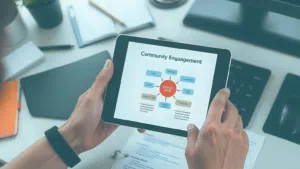15 Outreach Strategies Examples for Effective Community Engagement
Effective community engagement is essential for fostering strong relationships, building trust, and ensuring long-term success in any organization. Whether you are a business, nonprofit, or government body, implementing well-planned outreach strategies can significantly enhance your ability to connect with your audience. In this article, we will explore 15 outreach strategies examples that can help you engage with your community in meaningful ways.
What is Community Engagement?
Community engagement involves the process of working collaboratively with members of a specific community to address issues that affect their well-being, development, or interests. Successful engagement requires open communication, listening, and mutual respect.
Why Are Outreach Strategies Important?
Outreach strategies are vital because they help bridge the gap between organizations and their target audiences. They facilitate communication, promote trust, and provide opportunities for meaningful interactions. Outreach can also help raise awareness, increase participation, and achieve organizational goals effectively.
15 Outreach Strategies Examples for Effective Community Engagement
1. Social Media Campaigns
Social media platforms such as Facebook, Instagram, Twitter, and LinkedIn have become indispensable tools for outreach. By creating targeted campaigns and regularly engaging with followers, organizations can reach a broader audience and encourage participation.
Key Tactics for Social Media Outreach
- Use hashtags relevant to your community.
- Post visually appealing content like infographics and videos.
- Engage in conversations with followers by responding to comments and messages.
- Run polls and surveys to gather feedback.
Example
An environmental organization could use social media to promote an eco-friendly lifestyle by sharing tips and success stories from local community members.
2. Email Newsletters
Email newsletters remain a powerful outreach strategy for reaching specific audience segments. By curating relevant content and sharing updates, you can keep your community informed and engaged.
How to Optimize Email Newsletters for Outreach
- Personalize emails by addressing recipients by name.
- Provide valuable content like upcoming events, community news, and volunteer opportunities.
- Include clear calls to action (CTAs).
Example
A nonprofit focused on education might send out a monthly newsletter featuring success stories, fundraising opportunities, and upcoming community projects.
3. Community Events
Hosting community events, whether virtual or in-person, is an excellent way to engage your audience. Events provide a platform for face-to-face interaction, allowing for deeper connections and meaningful conversations.
Popular Types of Community Events
- Workshops or seminars on topics relevant to your community.
- Fundraising events for local causes.
- Volunteer-driven clean-up or service days.
Example
A local government could host a town hall meeting to discuss neighborhood concerns and solutions, allowing residents to voice their opinions directly.
4. Public Speaking and Presentations
Public speaking engagements are a highly effective outreach strategy for organizations aiming to educate or inspire action. Presentations at conferences, workshops, or community meetings can help spread your message to a targeted audience.
How to Make Public Speaking Effective
- Tailor your message to the audience’s needs and interests.
- Use visuals and storytelling to keep the audience engaged.
- Encourage questions and discussions to build rapport.
Example
A healthcare organization could host a seminar at a community center to educate people about the importance of preventive care and healthy living.
5. Collaborations and Partnerships
Collaborating with local businesses, schools, or other organizations can strengthen your outreach efforts by leveraging shared resources and networks. Partnerships allow you to reach a wider audience while benefiting both parties involved.
How to Build Successful Partnerships
- Identify organizations with aligned goals or missions.
- Establish clear expectations and mutually beneficial outcomes.
- Co-host events or joint campaigns to maximize impact.
Example
A charity organization might partner with a local restaurant to host a fundraising event, where a percentage of the proceeds go to the charity.
6. Influencer Outreach
Engaging influencers who resonate with your target audience can help amplify your message and drive participation. Influencers often have established credibility within specific communities, making them effective advocates for your cause.
Tactics for Successful Influencer Outreach
- Research influencers whose values align with your organization.
- Offer them incentives such as free products or exclusive content to promote.
- Encourage authentic storytelling rather than scripted promotions.
Example
A sustainable clothing brand could collaborate with eco-friendly influencers to raise awareness about its ethical production methods.
7. Door-to-Door Outreach
Although more traditional, door-to-door outreach remains an effective strategy, especially for local initiatives. It allows for personalized, face-to-face interaction, making it easier to build trust and address specific concerns.
How to Plan Door-to-Door Campaigns
- Train volunteers or staff members to communicate your message effectively.
- Provide educational materials or pamphlets to leave behind.
- Focus on high-traffic areas within the community.
Example
A local political candidate might use door-to-door outreach to meet potential voters, discuss their platform, and encourage participation in upcoming elections.
8. Surveys and Feedback Forms
Collecting feedback through surveys and forms is a great way to engage your community while gaining valuable insights into their needs and preferences. This allows organizations to adapt their strategies to better serve their audience.
How to Use Surveys for Outreach
- Keep surveys short and to the point.
- Offer incentives like discounts or free services for participation.
- Share the results and explain how the feedback will be used.
Example
A community organization might use surveys to gather feedback about the most pressing local issues and then plan future outreach efforts accordingly.
9. Volunteer Programs
Creating volunteer programs can empower members of your community to actively contribute to your organization’s mission. Volunteers often become long-term advocates for your cause, making this a highly effective outreach method.
Tips for Successful Volunteer Engagement
- Offer training and support to make volunteering accessible to everyone.
- Publicly recognize volunteers for their contributions.
- Provide opportunities for skill development.
Example
An animal shelter might recruit local volunteers to help with daily operations, such as feeding and caring for the animals.
10. Content Marketing
Content marketing involves creating and sharing valuable content to attract and engage your audience. Blogging, videos, podcasts, and infographics can all serve as tools to educate your community while highlighting your expertise.
Key Elements of Content Marketing for Outreach
- Focus on topics that address your community’s needs and interests.
- Use SEO strategies to make your content more discoverable online.
- Regularly update your content to keep it relevant.
Example
A mental health nonprofit could create a blog series on coping strategies for stress, which also provides resources for those seeking help.
11. Webinars and Virtual Workshops
With the rise of remote communication, webinars and virtual workshops have become powerful tools for outreach. They allow organizations to engage a global audience and share knowledge or expertise in a convenient, accessible format.
How to Run Effective Webinars
- Promote the event in advance through email and social media.
- Invite guest speakers or experts to add credibility.
- Provide downloadable resources or recordings for participants.
Example
A technology company could host a virtual workshop to demonstrate the use of its latest software, helping users better understand the product’s value.
12. Community-Based Advertising
Using targeted advertising in local media, such as newspapers, radio stations, or community websites, can help you reach a specific audience. It is especially effective for campaigns that aim to raise awareness within a particular region.
Tips for Effective Community Advertising
- Choose media outlets with a strong local presence.
- Use clear, compelling messages tailored to your community’s values.
- Monitor and evaluate the impact of your ads regularly.
Example
A local charity might run ads on community radio stations to promote a fundraising event and invite people to participate.
13. Hosting Focus Groups
Focus groups are small, interactive discussions that allow organizations to gather detailed feedback from community members. This outreach strategy is particularly useful when you want to explore complex issues or test new ideas.
How to Organize Focus Groups
- Select participants who represent different demographics within your community.
- Facilitate open, honest discussions to gain varied perspectives.
- Use insights from the focus group to shape future outreach efforts.
Example
A city council might host a focus group to discuss a proposed infrastructure project, gathering input from residents before finalizing decisions.
14. Advocacy Campaigns
Advocacy campaigns aim to rally community members around a cause, often involving petitions, rallies, or social media movements. These campaigns are powerful for mobilizing action and drawing attention to important issues.
Strategies for Successful Advocacy Campaigns
- Clearly define the cause and the desired outcome.
- Use storytelling to inspire empathy and support.
- Encourage community members to take specific actions, like signing a petition.
Example
An environmental advocacy group might launch a campaign to protect local wildlife, encouraging community members to sign a petition or participate in a rally.
15. Podcasts
Podcasts provide a unique platform for sharing in-depth conversations, stories, and educational content. Hosting a podcast can help you engage with your audience on a personal level, offering insights into your organization’s values and mission.
How to Start a Podcast for Outreach
- Choose topics that align with your community’s interests.
- Invite guest speakers to share their expertise.
- Promote your podcast episodes on social media and through email newsletters.
Example
A nonprofit focused on youth development might create a podcast series where they interview young leaders from the community, highlighting their success stories.
Conclusion
Effective community engagement requires thoughtful and consistent outreach. By leveraging these 15 outreach strategies examples, organizations can foster stronger relationships, enhance trust, and achieve greater impact in their communities. Whether through social media, events, or personalized face-to-face interactions, the key to success lies in selecting the right strategies that align with your audience’s needs. Start incorporating these outreach methods into your community engagement plan today to drive meaningful change and long-term success.
Looking to enhance your community engagement efforts?
Sash&Company offers expert outreach services tailored to your specific needs. Whether you’re a nonprofit aiming to mobilize volunteers or a business seeking deeper connections with your audience, our comprehensive outreach strategies can help you achieve meaningful engagement. Contact us today to learn how we can help you craft personalized outreach solutions that resonate with your community. Take the next step with Sash&Company – the leading provider of outreach services in South Africa.






